#Continuous Wave
Explore tagged Tumblr posts
Text

post oots - bramblestar's storm
#warrior cats#there will be a continuation.... in my brain. im sending it to u via my brain waves#jayfeather#lionblaze#dovewing#art#I FORGOT I HAD RBS OFF SORRY HAHAHA#I really wanted to post this when i had all the pages fogured out but i hit a wall. this happens too many times im sorry
5K notes
·
View notes
Text
Ham Radio: A Personal Account
by Kevin Gillette
Amateur radio, or ham radio as it is more commonly known, has been a hobby for millions of people around the world for approximately 100 years, give or take. It exists today for much the same reason it came about in the first place: it is (and was) a way for both amateur and professional engineers, tinkerers, physicists and inventors to interact with one another, comparing notes, ideas and innovations that have played a major role in the expansion of telecommunications up to the present day.
This brief memoir is not a history of the hobby, for I came into it only 50 years ago, in 1974. As a result, I don’t have first-hand knowledge of most of what came before. But I can sketch the essentials for you, and with any luck, I will persuade you to see how this hobby can bring a great deal of joy and satisfaction. At the end of this account I will provide some tangible evidence of my days at the helm of a transmitter/receiver/antenna combination over the course of several decades.
First, some preliminaries:
Ham radio began about 100 years ago. The very first enthusiasts used very primitive equipment for both transmission and reception. The earliest transmitters used a technique called spark gap in which the radio signal arose from a spark generated between two electrodes. The frequency of this transmission was dictated by the physics of the electrodes and the gap between them.
For frequency, think of your standard AM and FM broadcast bands, or local television. Radio emission occurs when an electrical field rapidly reverses direction – that is, electrons flow back and forth through a wire or some other device capable of supporting an electromagnetic field. The speed with which this flow of electrons reverses course determines the frequency; the faster the course reversal, the higher the frequency. A single round trip of the electrons is usually referred to as a cycle. Thus, frequency is expressed in cycles per second, or in an equivalent unit, Hertz (one Hertz = one cycle per second). All electromagnetic radiation can be expressed this way. Radiation typically occurs when the flow of electrons alternates direction - electron flow goes by the term current, and so radiation happens with alternating current, or AC. In many (though not all) countries, the electricity that comes out of a wall plug is AC. The opposite of AC is DC - direct current - and this is the case when the electrons always flow the same direction. In essence, DC is zero Hertz AC.
The range of hearing of most humans is between about 60 Hertz (Hz) and roughly 10,000 Hz (this is also indicated as 10 kiloHertz, or 10 KHz). In the United States, the AM broadcast band is from 540 KHz to 1600 KHz (this latter measurement is also expressed as 1.6 megaHertz, or 1.6 MHz). Standard television signals have traditionally begun at 54 MHz, which each television channel occupying a total of 6 MHz. So this means that Channel 2 (for obscure reasons, there is no Channel 1) is from 54 – 60 MHz, channel 3 from 60 – 66 MHz, and so on. There is a break in this pattern for the U.S. FM broadcast band, which lives from 88.0 – 108.0 MHz; the TV channels then continue up to channel 13. The channels 2 through 13 are called the VHF - Very High Frequency - channels. After channel 13 there is another significant frequency gap, after which the UHF, or Ultra High Frequency channels begin, with channel 14.
I’ve mentioned a couple of undefined terms: AM and FM. AM stands for Amplitude Modulation. This was the earliest method used for transmitting sound signals (voice, music, etc). It works by using a central frequency known as the carrier and superimposing an audio frequency on it, resulting in the actual size of the emission varying (at the carrier frequency) according to the audio frequency. This methodology gives rise to what are called sidebands, which cover the frequencies between the carrier frequency plus and minus the audio frequency. This is still used today on the AM broadcast bands in most countries. It is rather wasteful in terms of power, since a lot of the transmitted signal power is in the carrier itself rather than the sidebands where all the good stuff is. For this reason, ham radio operators who do voice transmissions have, since about the 1940s or so, used something called SSB, or single sideband transmission. In this mode, one chooses one of the two sidebands (lower or upper) and suppresses the other one as well as the carrier, meaning that most of the transmitted power goes into the information in the signal rather than being wasted. A more recent form of transmission is FM - Frequency Modulation. In FM transmission, instead of varying the amplitude of the carrier wave as a function of the audio content, the frequency wiggles according to the superimposed audio content. In AM transmission, static and other interference phenomena tend to occur at the peaks of the modulation waveform (see the figure below); with FM, the peaks of the waveform don’t contain information so they can be filtered out, and this gives rise to the notion - largely true - that FM is static-free. Here is an example AM waveform as seen on an oscilloscope:
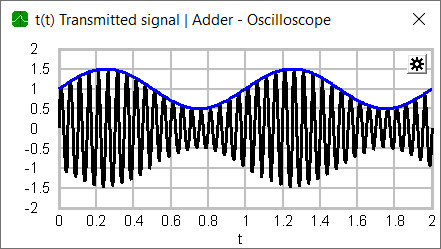
For comparison, here is an example of an FM waveform as seen on an oscilloscope:

In this latter picture, notice how the amplitude of the waveform doesn’t change, but the spacing between the cycles does – this is the wiggle in the frequency I referred to earlier.
I mentioned voice operations in ham radio using a technique called SSB. There are other techniques, especially at the higher frequencies, but I’m not going into those here. I admit that I am something of a purist; I have always preferred to use Morse Code in my ham radio exploits. This is known as CW - Continuous Wave - in the ham radio community. The idea is that to transmit Morse Code, one merely turns a carrier – a continuous wave – on and off with a Morse Code key or something equivalent to it. Speed of transmission is usually expressed in words per minute - wpm. Although the requirement is gone today, in the past, obtaining a ham radio license required the operator to demonstrate at least a basic proficiency in Morse Code, usually somewhere between 5 and 20 wpm. A word in this context is a group of 5 characters and the space after them. I’m proud to say that at my peak, I could listen to – “copy” – transmissions running at about 45 wpm. The world record in those days was somewhere in the neighborhood of 75 wpm, and high-speed code operators in the US Navy and elsewhere typically operated at around 50 wpm, so I was competitive in the CW community as far as speed.
I’ve talked a lot about transmission, but of course it’s all for naught if there’s no way to hear the signal. To do this, one needs a receiver. Receivers are generally much more complicated devices than transmitters – even a modern transmitter can often be constructed with perhaps a dozen discrete parts, including the power supply (or batteries), whereas modern receivers typically need about 10 times that amount in order to be effective and reliable. This is because transmitting is essentially an increasing entropy operation from a thermodynamic perspective, whereas receiving is a decreasing entropy operation, which fights against the tendency toward greater entropy according to the 3rd Law of Thermodynamics. This is much the same as it being a lot easier to generate heat than to remove it from an environment. Receivers are far too complicated to get into here, but I will note that for the kind of work I did – CW and Morse Code – the way the signal could be heard was to tune the receiver to a frequency just slightly to one side of the transmitting carrier frequency and use what’s called a BFO - Beat Frequency Oscillator - to provide a sidetone that represents the difference between the BFO frequency and the carrier frequency. This will be important a bit later, so remember that term.
And of course the ensemble isn’t complete without some kind of antenna. Like both transmitters and receivers, antennas can be everything from a simple piece of wire to a very elaborate contraption that covers a lot of real estate. The rule of thumb is that the higher the frequency, the smaller the antenna needs to be. A very common kind of antenna used on the lower ham radio bands is a vertical antenna, which as the name implies, is a piece of metal (usually aluminum) that is vertically installed. The cable that connects the antenna to the transmitter and receiver is usually attached at the bottom of such an antenna – a picture of such an arrangement appears below:
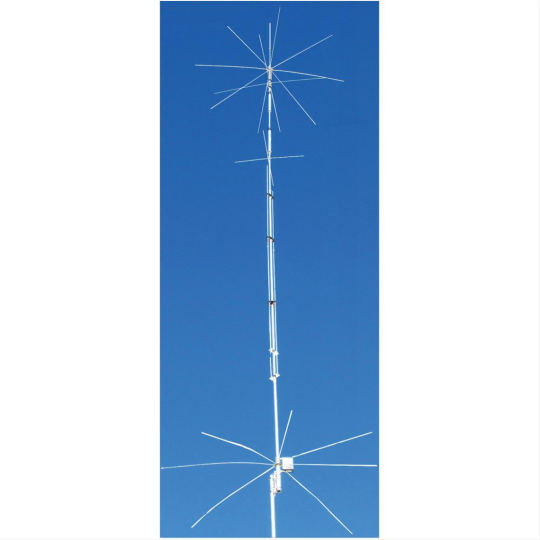
In this photograph, the antenna has some extra horizontal spokes coming off of it at various points – these are used to suppress capacitance effects of the central pole (the fact that it’s a hollow tube and not an infinitely thin wire causes some of these issues to arise) and to otherwise improve the performance of the antenna.
I haven’t said much about power, so I’ll do so now. Where commercial broadcast stations can transmit at quite high power – varying from 1000 watts to upwards of 100,000 watts – ham radio is restricted to a maximum of 1000 watts for CW and 2000 watts for SSB. I was typically a low-power operator, seldom going above 50 watts and often no more than 10 watts. And yet I was able to make contact with people all over the world on such modest power, so it doesn’t take a lot. An effective antenna system and favorable geography are the primary arbiters of how well one can communicate over long distances.
Something else I mentioned but haven’t yet elaborated on is the licensing process. In the United States, there used to be the following levels of licensing, from the most basic to the most advanced: Novice, Technician, General, Advanced, Extra. I began my ham radio career as a Novice, as everyone did in those days. My radio call sign was WN6FEB (see photo below). To obtain a Novice license, one had to know some basic electronic and radio theory, some basic regulatory stuff (power, bands, on-air protocols, etc) and have mastered Morse Code at 5 wpm. I obtained this license when I was 13 years old. A short time later I upgraded to a General class license and a slightly new call sign, WA6FEB, which extended the radio frequency bands I was permitted to operate on and also extended my maximum output power (as a Novice I was restricted to 100 watts, I think). The General class license required knowledge of more advanced electronics and radio physics, a bit more regulations and Morse Code proficiency of 13 wpm. A few years later I took the plunge and got my Extra class license, which expanded the knowledge base from the previous two licenses and required Morse speed of 20 wpm. As an Extra class ham, I had unlimited access to all internationally agreed-upon ham frequency bands and full power rating. My main motivation in getting the Extra class license was the radio bands – I was never a high-power operator.
My Novice license QSL card (more on this in a moment):
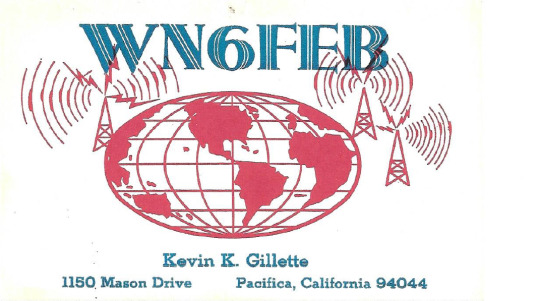
My Extra class license QSL card:
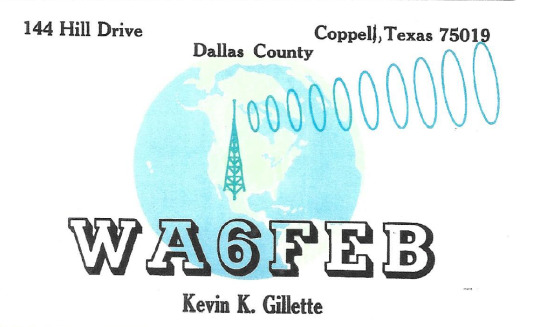
QSL cards are like postcards for hams – we often exchange them to acknowledge that we’ve made contact. They’re often attractive and make great wallpaper or collectibles. I’ve amassed quite a few over the years – there are examples of QSL cards received from around the world at the bottom of this article.
Dovetailing with a previous paragraph, a few words about ham radio frequency bands. Per international agreement, ham radio operators have a large number of radio spectrum segments allocated for their use. It should be noted that in many cases, these allocations are not exclusively for ham radio. One example is the 40-meter band, which covers 7.0 – 7.3 MHz. At least in the 1970s and 1980s, this band featured a lot of non-ham activity, including over-the-horizon radar from the USSR and Voice of America broadcasts from various parts of the world. What made this especially annoying is that the 40-meter band was almost universally open, meaning that effective communication could happen on that band at any time of the day or night, year-round. The Soviet radar sounded like a very loud metronome, and Voice of America was an AM transmission in a segment of the radio spectrum where people didn’t normally use AM, meaning that receivers tuned to this part of the spectrum ended up hearing the carrier as well as the audio signal (which made the audio portion hard to understand). Still, for a young ham radio aficionado hunting for exotic call signs in the ether, it was a lot of fun to wade among the incoherent mass of radio transmissions.
The bands are usually referred to by their approximate wavelength. Recalling that light travels at approximately 300,000,00 meters/second, here is a sample of some of the bands that were popular when I first started back in 1974 (there have been additional bands added to the spectrum since that time; I have no experience on those bands):
HF:
160 meters – 1.8 – 2.0 MHz (I didn’t have any contacts on this band, but my older receiver permitted me to listen in. The antenna requirements for this band are too large for the real estate I had.)
80 meters – 3.5 – 4.0 MHz
40 meters – 7.0 – 7.3 MHz
20 meters – 14.0 – 14.35 MHz
15 meters – 21.0 – 21.45 MHz
10 meters – 28.0 – 29.7 MHz
VHF:
6 meters – 50.0 – 54.0 MHz (note that this is just below the start of the standard television broadcast segment, Channel 2, as noted earlier)
2 meters – 144.0 – 148.0 MHz
I also mentioned the idea of a band being open. On the HF (High Frequency) bands, the propagation of a signal often proceeds in two ways: ground wave and sky wave. Ground wave is exactly as the name implies; the radio signal follows the ground. This signal is of comparatively short distance, perhaps 100 miles or thereabouts. Sky wave is quite a different phenomenon and involves the signal bouncing off of the ionosphere, a layer of our atmosphere that lives between 50 and 600 miles above the Earth’s surface. As the name suggests, this layer contains a lot of ionized particles - mostly from the Sun’s interaction - and it is this layer of ions that forms a sort of reflecting barrier for radio waves below a certain frequency. The highest frequency for which the ionosphere is a reflecting barrier is referred to as the MUF - Maximum Usable Frequency. Above this frequency, radio transmissions pass through the ionosphere and out into space. When a band is open, that means that the MUF is greater than the band’s frequency, at least as an approximation. The 40-meter band is virtually always below the MUF, meaning that it’s open all of the time. This is what makes it so popular. The 20-meter band is often (though not always) open, which is what makes it a premium band for long distance communications, referred to in ham radio parlance as DX (which stands for distance). The 20-meter band has the advantage that it is strictly for ham radio – no competing services cause interference and noise. When an HF band is open, the sky wave mode of signal propagation is also referred to as skip, meaning that the signal will skip off of the ionosphere, sometimes multiple times – this makes for worldwide transmission and reception.
You may be asking yourself what was in it for me, that I would have such fervor for a hobby that is admittedly declining in popularity (with the advent of email and the Internet). I think a simple anecdote will make it clear:
When I was about 15 years old, early in my ham radio career, I lived in a small town near San Francisco and also near Stanford University. I had an on-air friend named David Gray, WB6ZMJ, who was a graduate student in geophysics at Stanford. David was a member of the Stanford Amateur Radio Club (SARC):
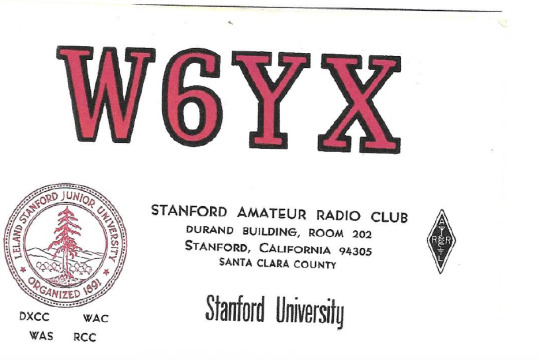
One weekend he invited me down to Stanford to participate in what is known as moonbounce. In moonbounce, hams from across the globe will transmit on the VHF frequencies directly up to the Moon, bouncing their signal off the Moon to be received somewhere else on the planet. Recall what I mentioned above about the MUF; the VHF frequencies are all well above the MUF, so VHF signals cannot participate in the skip mode of propagation (except under some very unusual circumstances). Stanford University has an enormous radio telescope, affectionately referred to as The Dish, that sits on a small hill on the SW side of campus. A picture of it appears below. The Dish is about 150 feet across and was built in 1961. It remains in use to this day. The SARC used The Dish as their antenna for moonbounce activity.

Here's the rub: The path length from Earth – Moon – Earth (EME) is about 500,000 miles. The loss in signal strength approaches 250 dB, which equates to dropping from a Formula 1 roar down to the tiniest of whispers. In fact, the signal strength is so low that even when using CW, the signal isn’t strong enough to trigger a BFO for a sidetone in order to read the signal. The only way to hear the signal is to listen for quiet spots in the background noise! That’s where I came in on this particular occasion. I have (and have always had) exceptionally acute high-frequency hearing, and so what sounded like white noise to the grad students in the SARC was an intelligible signal to me. So, in the middle of the night, there I was, in the metal housing seen at the base of The Dish, listening to a mysterious CW signal from a ham in Sweden coming by way of deep space, and writing down what I heard. For a lonely, nerdy kid, this was the height of affirmation – it was OK to be nerdy and science-oriented when you got to play with such exotic toys! Indeed, not only did this experience cement my desire to pursue ham radio; it also confirmed that Stanford was the place I wanted to pursue my university studies (as indeed I did, graduating with a Bachelor’s degree in applied mathematics and a Master’s degree in operations research, all before my 21st birthday).
In the years following graduation from Stanford, I got married and moved to Dallas, Texas, where once we purchased our first home, I immediately set up a nice ham shack in the laundry room. I made tons of great contacts all over the world with the most modest of equipment (alas, I don’t have any photos of my gear from those days). When we started our family, the hobby had to take a back seat, and eventually I let my license lapse. But now that I am approaching retirement age, I long once more to get back on the air and hunt for those mysterious signals beaming in from everywhere.
Kevin Gillette, 26 January 2024
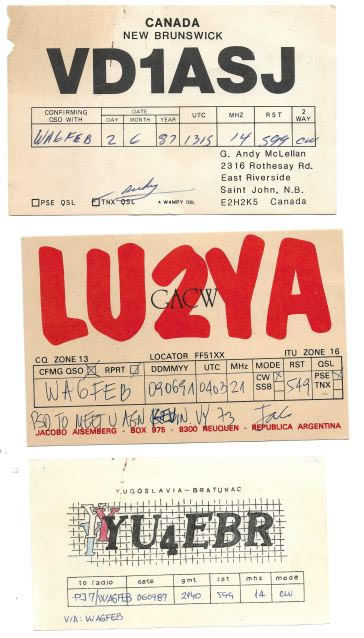
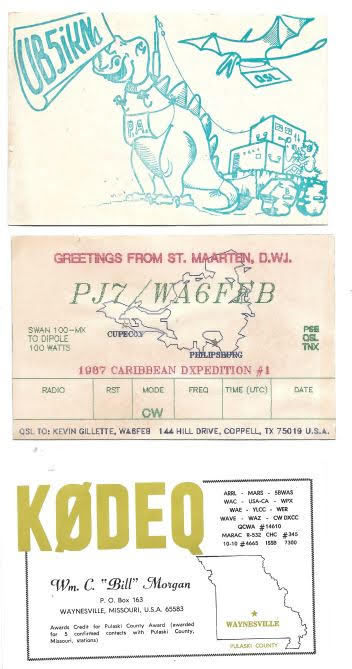

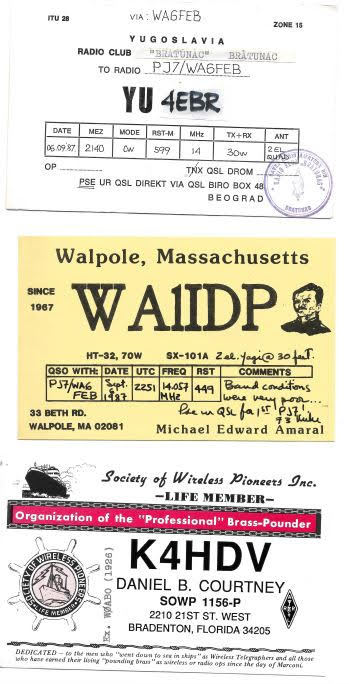
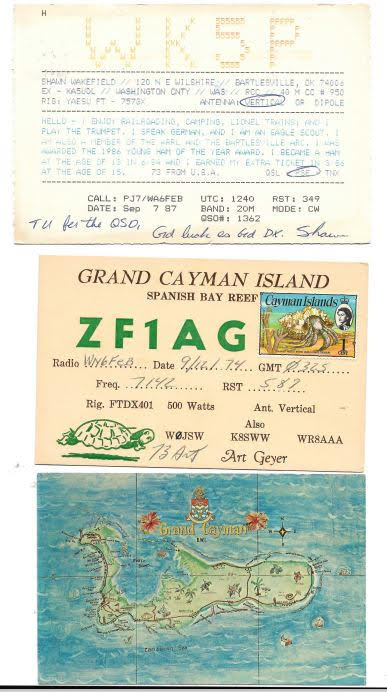
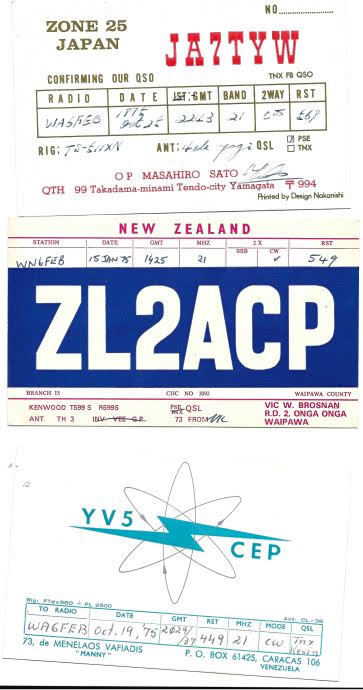
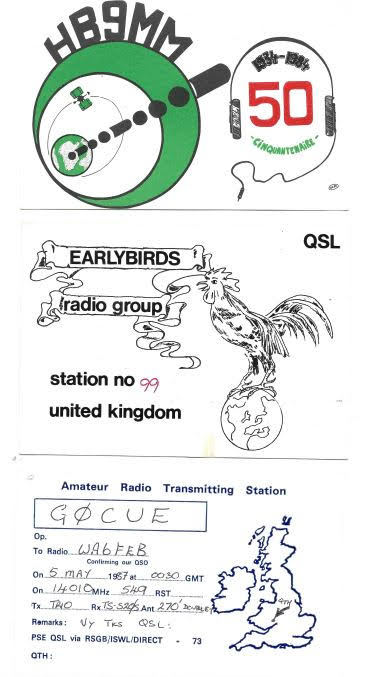
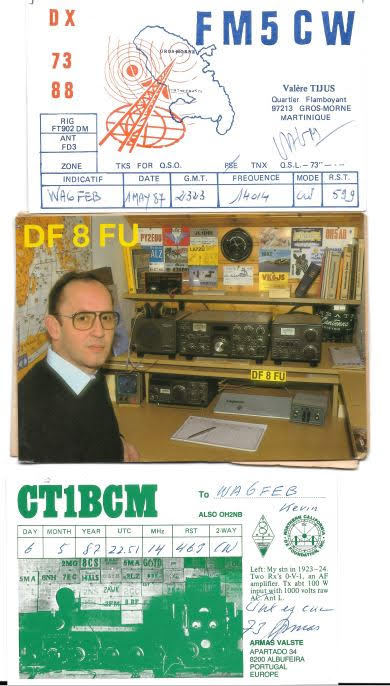

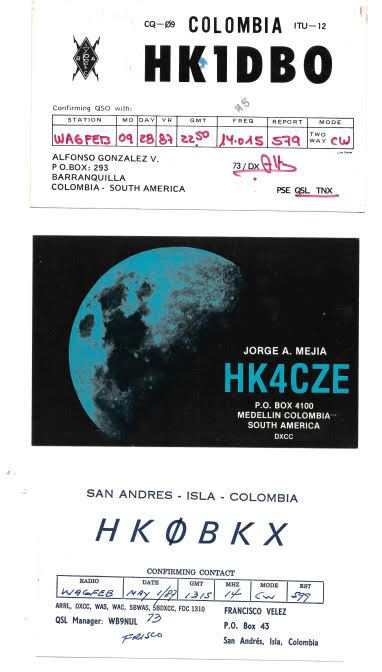
Image credits : Images in the text with thanks to © respective creators and publishers. QSL Cards at end of article above received by author, with thanks to © respective creators
Kevin Gillette
Words Across Time
26 January 2024
wordsacrosstime
#Words Across Time#Kevin Gillette#wordsacrosstime#January 2024#Amateur Radio#Ham Radio#Broadcast Bands#Electromagnetic Field#Stanford Amateur Radio Club#Beat Frequency Oscillator#US Navy#Morse Code#SSB#AM#FM#Maximum Usable Frequency#Sidetone#Sidebands#Continuous Wave#Antenna#Spark Gap#Hobby#Tinkerers#Inventors#Telecommunications#VHF#Frequency Modulation#Amplitude Modulation#Alternating Current#Direct Current
1 note
·
View note
Text


He hasn't changed ☹️💗
#his love for dragons from the beginning is so beautiful#I'm so happy that he and Pyrrah are friends#THAT SCENE WHERE PYRRAH ARRIVES WITH ZUBEIA AND HE STARTS TO WAVE TO HER It's so adorable#and I didn't want to give spoilers but... I'm drawing soren and pyrrah#the dragon prince#soren tdp#tdp#give us the saga#giveusthesaga#continue the saga#continuethesaga
683 notes
·
View notes
Text


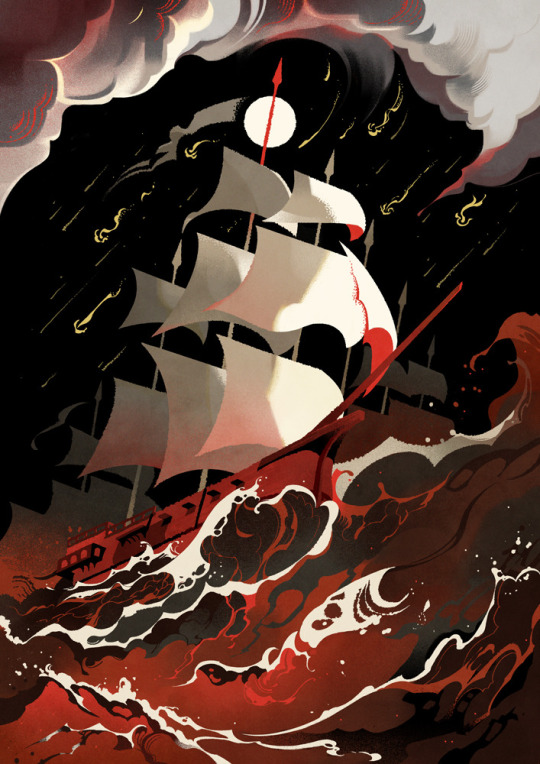
The Hidden Isle Kickstarter is now live!
Don’t miss out on preordering a new TTRPG played with Tarot cards 🌊
The Hidden Isle is a pen and paper RPG that uses Tarot cards instead of dice, set in the 16th century on the secretive island of Dioscoria. It focuses on roleplaying and collaborative storytelling.
This is a game about swashbuckling adventures across Europe and the Middle East, stealing forbidden texts from oppressive regimes, protecting an island of outcasts using ancient magic,and toppling empires with just the right speech at just the right time.
It will run for 30 days, until October 28th 2023.
#ttrpg#artists on tumblr#art#indie rpg#tarot#tarot art#swashbuckling#illustration#renaissance#renaissance art#kickstarter#i will continue drawing sexy people and waves for this so if you want to support my creative endeavors pls check out this KS
4K notes
·
View notes
Text
The young princess is missing.
Which is… nothing alarming or even new, as odd as it sounds. But Changxi’s mistress is not the sort to stay put in her palace and while away her days idly. In fact, it’s quite rare to find her within the palace at all. The young princess returns here once every few years, or even less; most of her time is spent out in the deep waters felling vicious monsters, or exploring the shores above the sea.
Now, this would not be unusual behavior coming from a sharp-eyed general mapping out their surroundings and establishing order in their territory. But coming from a young child?
The young princess had practically been a newborn when Lord Osial granted her the Coral Pavilion!
… But even so, blood runs true nonetheless.
Despite how Changxi’s princess had been all but abandoned since the day she was born, she easily proved through her actions what so many sea-folk furiously denied as a mistake: She was, beyond any trace of doubt, a god’s daughter.
Noble in her bearings, and possessed of great strength far beyond her years.
It shames Changxi, to recall how he’d initially regarded the young princess with cautious trepidation, and a small degree of disgust. The princess’ true form is… aberrant, certainly. But that is through no fault of her own! And appearance is quite unimportant in the grand scheme of things, especially when the princess’ character is more than enough to make up for any physical peculiarities.
Besides, if one thinks about it, the thick mane of fur is rather cute against the backdrop of gleaming white scales, isn’t it?
… Admittedly, Changxi is probably one of the extremely few among sea-kin who hold this perspective.
Overall attitudes towards the young princess are mixed. Even though Lord Osial had torn out his own scales and poured divine blood into the waves, raising an expansive underwater palace of glowing coral spires and crystal towers as a gift for his daughter, never once had his attitude towards her been anything like that of a father towards his own child. Nothing like the soft smiles for Prince Ao, or even the stern reprimands when the young prince created a mess as a troublemaker.
For the young princess, the Coral Pavilion had been the sole sign of acknowledgment from Lord Osial.
She’d never even been granted a name of her own!
A name was a sign of love and care from parent to child. Or at the very least, a tangible connection binding an individual to the blood and lineage that they hailed from.
Yet Lord Osial had never named his firstborn daughter.
Princess Su was a placeholder, a moniker that wasn’t even really a proper title despite the formal use of ‘princess.’ Because ‘Su’ is the name of the cunning fox that had deceived Lord Osial and escaped before justice was meted out. Referring to the princess by the name of her malicious mother was something that would only ever stress the blood of betrayal and deceit that ran in her veins, that marked her as something other from her sea-born brethren.
But Lord Osial had never accepted her as his daughter, had he?
There was no proper name to address the first princess by. And so, Princess Su had begun circulating as a title for her, one that had been born both out of necessity, and of an unspoken perverse desire to mock the creature that was the fruit of a false union that shamed their Lord.
When Changxi came into power as the head of all servants in the Coral Pavilion, the first thing that he’d done was ban the usage of ‘Princess Su’ on their tongues.
Within the Coral Pavilion, the princess will simply be addressed as ‘Princess,’ he’d demanded, brooking no arguments. The bloody example that he’d made of those who scoffed and refused to comply had been enough to convince the rest of them to follow.
… That is all that Changxi can do.
Because ultimately, Changxi is not a powerful general, nor an influential ally who might change Lord Osial’s mind towards his daughter. The young princess, too, does not appear to desire improving her relations with her father –which Changxi cannot fault her for, but nonetheless does not stop him from worrying.
It is only by Lord Osial’s grace that the young princess is granted the right to reside here. What happens if he one day decides to retract this?
The young princess is the reason why these waters have calmed; why old, opportunistic monsters lurking in the deep waters no longer seek to assault the borders of Lord Osial’s territory. She is also the reason why humans living on the surface have begun praying to the seas, instead of leaving and seeking the protection of other gods warring throughout the lands.
Surely if Lord Osial knows of this, he would properly acknowledge her efforts?
“You know as well as I do that the princess isn’t doing any of this for acknowledgment.” Beside him, a silver carp spirit rolls his eyes. “That’s probably the last thing she’s concerned about, really. The first thing that she’s concerned about is probably be something like, ‘What’s on the lunch menu?’”
Changxi gives his cousin a flat look. “The princess doesn’t even take her meals in the Coral Pavilion.”
“But she likes hunting, doesn’t she?” Yingfu blinks wide silver eyes back at him, innocently mischievous. “Think we’ll get to see her bite the head off of another arrogant avian adeptus? Or rather, heads?”
The nine-headed feng was not the only one who’d experienced a heart attack that day, even if it ended up being the only one to actually die in the end. “I think you have far too much free time on your hands, Yingfu.”
“I do, yeah, but what can you do about it?” Yingfu sighs. “The princess is never even around for us to serve to begin with! Which makes this an easy assignment, but it’s also so… so…”
Before Yingfu can find the word that he’s looking for, the currents around them shift and change.
Changxi immediately straightens; he is familiar with this particular chill of energy. It must be–
“Princess,” Changxi turns towards the coral archway, “You’re finally back. I sincerely welcome… your… return…”
He trails off speechlessly, staring.
In front of him, the fox-jiao shakes its head and stretches, and the rippling motion travels through the serpentine length of its body. Diamond scales glitter and dissolve into seawater, as do long strands of soft white fur, and within moments there is no longer a chimeric beast-spirit standing in front of Changxi but a little human girl. A girl with the same foam-white hair and fathomless blue eyes–
–who also happens to be holding onto a… young… bird spirit?
“Oh my,” Yingfu murmurs quietly, and Changxi completely understands his cousin. The bird spirit wears the form of a young boy, but this boy does not resemble any human child that Changxi has seen before, whether it be from small fishing villages or Lord Osial’s underwater city.
The injuries that this child is sporting, dear god. There are deep cuts and lacerations in the boy’s body that look like age-old injuries, and his arm is crooked, as if a bone hadn’t been properly set straight after breaking. Large patches of skin are a mottled purple-black, heavy bruising enough to make Changxi wonder how this boy is even standing at all.
It’s not the princess’ handiwork. Some of these injuries look to have been deliberately inflicted for the sake of torture, and the princess has never been one for prolonging suffering meaninglessly.
… In fact, now that Changxi is paying closer attention, he notes with a sharp spike of alarm that there’s an elemental imprint on the bird spirit. A clear, possessive imprint that belongs to another god!
“Princess,” he swallows roughly. “Where did you find this boy? Are you aware that he’s–”
“Fix him, Changxi.”
The words die in Changxi’s mouth as he stares at his princess. This is the princess whom he has sworn himself to; the one who had never seemed emotionally attached to anything at all around her, yet carried out her duties as if it were an ingrained instinct. Even when so many feared her, isolated her. Even when her own parents had abandoned her–
Fix him, Changxi.
… When was the last time that his princess had looked directly at him, and addressed him by name like this? When has his princess ever asked Changxi for anything?
…
Changxi bows his head, as does Yingfu beside him.
“As you command, princess.”
#writing#zenith of stars au#adeptus au#as you may have guessed#changxi is indeed our version choki from zenith#his cousin mentioned here is actually the young chauffeur who tragically died early on in zenith#anyways another note#yes xiao is underseas here#you can imagine his surprise when the fox noodle dragged him down into the waves#maybe i should write a continuation of the xiao-shiki meeting sometime hmm
110 notes
·
View notes
Text
















Jacques-Fabien Gautier D'Agoty, Two dissected heads, 1764-65 | Ryan Condal, House of the Dragon, 2022- | Richard Kern and Lydia Lunch, The Right Side of My Brain, 1985 | Swans, Love Will Save You, 1991 | Nick Cave and the Bad Seeds, Hard on for Love, 1986 | Richard Kern, Stray Dogs, 1985 | Anna and Elena Balbusso, Canterbury Tales Illustrated, 2014 | Scott Walker, Cossacks Are, 2006 | Théodore Géricault, Study of Feet and Hands, 1818-19 | Andrew Marvell, Last Instructions to a Painter, 1667 | Francesco Cozza, Death of Cleopatra, 1675
#larycent#house of the dragon#hotd#alicent hightower#larys strong#hotd analysis#webweaving#alicent x larys#the right side of my brain#richard kern#no wave#hashtag YEPPP NOWAVE POSTING CONTINUES!!!
180 notes
·
View notes
Text
Canonically, we know AOS Kirk is a fan of the Beastie Boys - or at least Sabotage
What other 20th and 21st century music do you think he listens to?
And why is the correct answer Mr. Brightside by The Killers?
#he listens to it in the shower#singing ironically at first and then sobbing#and spock is in his quarters trying desperately to ignore both the singing#and the waves of angst radiating from the direction of their shared bathroom#this continues even after they bond#Spock’s just like babe what did I do#star trek#Star Trek aos#star trek shitposting#spirk#spirk shitposting#Kirk#jim kirk#spock#aos kirk#aos spock#it could also be tos I’m not here to judge tbh#I just always imagine aos when it’s something ridiculous#but like sure#star trek tos#james t kirk#k/s#spock/kirk
57 notes
·
View notes
Text






There's an awkward "first date" silence between them, the kind that suggests there isn't going to be a "second". Giselle tries her best to keep the conversation going.
#giselle philip#king edward#enchanted#disneyedit#enchantededit#enchanted 2007#enchanted movie#prince edward#amy adams#rucksack*#so much I love about this scene#the way she's awkwardly playing with her hair#edward's confusion when she says “the day AFTER that”#the way they're just not on the same wave length At All#the very unexcited tone in her voice when she says “well I'm very excited about that but...”#followed by the immediate joy she feels when she sees/orders their hotdogs#like she's so excited for that food it's probably the only part of that date she did enjoy#meanwhile edward just wants this shit to end so they can leave#like he's so bored and uninterested in everything she says#also it's not mentioned here but in the script she continues and mentions wanting to open a small business#and possibly do volunteer work too#and edward doesn't understand even a little bit#god. their date is just. so good. they're both so utterly miserable the whole time I love it so much
172 notes
·
View notes
Note
Can we get relationship hcs w/ calcharo please? He’s so cool siskhsosjsoshsksjsjs
He's very neat I like him! I haven't properly met him in game yet though. I go off of the lines I hear when I forget I'm standing in a boss area and the boss respawns.. :pensive:
I hope you like these!

-Reiterating what I said in my Cuddling HCs, most people don't know he's in a relationship or has a partner. It probably happened accidentally, Calcharo wouldn't pursue somebody on purpose. He'd put his own feelings aside. So when you told him about yours, well..
-He did try to deny you at first. But Calcharo wasn't really prepared for you to say anything! So he broke, because of course he did. Avoided making eye contact, arms crossed over his chest, the whole shebang.
-But you captured his heart! So here we are. He doesn't bring you conventional gifts, no flowers or chocolates or cute stuffies. Actually, scratch that last one, he did bring you this crocheted dog with the cutest silver beady eyes. He refused to tell you where he got it from though..
-BIG kisser. Calcharo's lips are surprisingly soft, they're a bit cold, but he makes up for it with frequency. Loves to hold you and kiss you, tends to kiss all over your face before finding your lips. This is how he greets you when he gets to greet you in private.
-His favourite food voiceline is "Huanglong's emergency rations. They taste slightly better than those made elsewhere." which sounds like me when I got French MREs during my military time and that's REALLY embarrassing for him. Tease him about it and he'll scoff and look away. (his real favourite food is whatever it is you like cooking. even if it is instant noodles.)
-In public, he treats you the same way he treats his people. Honestly? Chances are you're ONE of his people. Calcharo's skills span many subsets, this includes deception. He doesn't spare you a second glance, or even a first one.
-He apologises for the above in private often in an attempt to seek reassurance that you understand. And when he gets that he's back to holding your waist and looking over your shoulder at whatever it was you were doing.
-Calcharo comes in through the window sometimes and has a habit of startling you and he finds it the funniest thing in the world. Probably one of the few times you'll hear him LAUGH.
#Wuthering Waves x reader#wuwa x reader#Calcharo x reader#༻Stygian#༻Tenebris#༻Decree of chris-continues
277 notes
·
View notes
Text

black shores next patch!!!!!!!!!!!! encore n AALTO!!!!!!!!!!!
#wuthering waves#aalto#wuwa aalto#wuwa encore#black shores#kniceart#i dont remember if i have a chibi tag so ill go look for it#paper versions will be handed out for free if i find u irl#i think these will also be available on the snakeberryart store at some point too in better qual#but dont quote me on that#anyways im really happy with this style and i hope i continue to develop it :)#favorite coworker duo
90 notes
·
View notes
Text
Season 4 (and after) characters who wear capes
*note: Since I've been scanning the season 4 artbook and got way too annoyed at the amount of CAPES I've seen, I decided to list EVERY SINGLE character who wears one just to show you how much of a problem this has become💀💀 And yeah I included Oropo's special episode for being an extension of season 4.*
Yugo
Amalia
Dally (his cape goes back to normal in Waven)
Madagaskane
Armant
Aurora
Lance Dur
Queen Astra (Bonta Queen)
Queen Astra's wife
Eniripsa Queen
Astrub's governor
Brakmar King
Brakmar general
Sufokia Empress Mabel
Prince Adale
General Mofette
Every.single.elite.eliatrope.
Oropo
Qilby
Nora
Toross Mordal
Sram necromes
Grougaloragran
Bouillon
Sidaire
Ripulse
Julith
Grougalorasalar
Yrehn
Count Harebourg
#unfinished list cuz i know there's gonna be more#tot has a cape collection#it all started with julith#and now look where we are#this rly became a cape obession#tot is even continuing this cape habit in the great wave manga 😭😭#wakfu#ankama#krosmoz#wakfu season 4#wakfu s4#wakfu season 4 artbook#wakfu s4 artbook#artbook#wakfu artbook#season 4 artbook#s4 artbook#wakfu the great wave#wakfu the great wave manga#wakfu manga#the great wave#the great wave manga#wakfu oropo special#oropo special#wakfu oropo special episode#oropo special episode#wakfu oropo ovas#wakfu oropo ova
54 notes
·
View notes
Text
Just coming on here and giving everyone a huge hug this morning. We’re officially at the two week mark. We’ve all done so much, and so much has happened in that short time frame.
I know so many of us are tired, or discouraged, or burnt. But just know that all of you are so so lovely, and even the smallest things are so so appreciated. Whether that’s filling out the feedback forms, tweeting at the other platforms, reblogging information, being here to lift others up, or taking time to yourself so you can come back for another push later, you’re all doing so, so well.
If nothing else, we’ve all managed to come together, and to shower the cast and crew with so much love.
So I’m sending that same love y’alls way, too. Keep up the good work, keep those fingers crossed, and mostly importantly, take care of yourselves 💜🏴☠️
#OFMD#SaveOFMD#Renew as a crew#Adopt our crew#Know a lot of people are PARTICULARLY wiped with all that happened yesterday#So just know that I’m wrapping blankets around you and consensually kissing yalls foreheads#HOPEFULLY we can indeed woo a platform#And HOPEFULLY we can indeed see more light again#I’m going to keep pushing and pushing and pushing until Dad waves the white flag#And I of course others to continue shining as well#But ALSO do what’s best for you#Take a breather#Step away for a bit#Change tactics#Etc etc
228 notes
·
View notes
Text

hacker voice: i'm in
#transformers#maccadam#soundwave#transformers fan continuity#tf shipwrecked au#transformers fanart#raud posts art#another wave cause hes my fav
297 notes
·
View notes
Text

🚨 Panik 🚨
#perryshmirtz#human!perry#human perry the platypus#phineas and ferb#pnf fanart#heinz doofenshmirtz#artists on tumblr#didi-art#hello perryshmirtz nation I offer my humble contribution#perry as civilian just waving at him bc they made eye contact#sending doof into a spiral bc what do you mean this guy aknowledged me#smiled AND waved????? 🚨🚨🚨#perry the platypus will have no inator to thwart tomorrow. he’ll just have to listen to doof ramble about this guy he met#he will however never mention the guy having teal hair. bc this is a common occurence for doof.#thus the cycle of pining continues#we love to see it#anyway I like how this turned out. proud of it ✨
40 notes
·
View notes
Photo

always gold, radical face
#ronsey#ronan lynch#richard gansey#the raven cycle#trc#the raven boys#the dream thieves#blue lily lily blue#the raven king#the entire song was written for them i might make a continuation of this w more of the lyrics at some point#also as much as i have been riding this art productivity wave lately my wrist is in dire need of a break so back to the void i go for a bit
696 notes
·
View notes
Text
Noooooooiiooiiioooooooooooooo my eiden in a fluffy magical skirt what do u meeeeeean he's not carbcsptkr eoitooooo

#i am becoem beached#dried out... husk... as the wave slaps me continually#well. it's ok. he can be Just Some Guy too#it's part of his appeal. he can do it all!!!!#at least he wore the skirt once!!ONCE!!! he didn't schwopp out of it like a CERTAIN TSUNLORD#today. he will be tuxeito mask.#the magical girls (blade and garu) need Some Guy with a Rose supporting them#kuya's a straight up witch he did his mandatory MG courses centuries ago#can't even call him a magigirl. mistress magic. something. that's like calling a phd a high school diploma#or. actually. alternatively. opopositionally. what if kuya is the LOWEST ranking magical girl#he won't even play along with the tropes! he won't wear the puffy skirt. he won't say the incantation#NOT scoring high in the genre requisites right now#chronic underachiever. bottom of the class. blade is valedictorian right now#where was i#right. eiden in another adorable skirt#that's fine!! we'll always have sweet heart maid cafe hours#*pulls a tiny photo of eidream out of my wallet*#*sighs longingly*#shine gemstone heart
24 notes
·
View notes